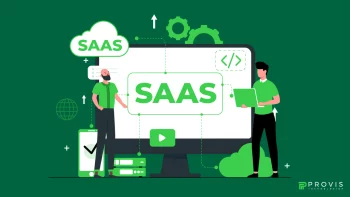Have you ever thought that creating a CRM system specifically for your business could provide a seamless customer experience and efficiency?
In 2025, it is evident that custom CRM systems are not just a normal business solution. Instead, they come hand-in-hand, offering companies the flexibility to customise everything from the user interface to integrations that match specific business needs.
This guide will cover all steps of building a CRM, starting from planning and development to deployment!
By the end, you’ll have a complete roadmap to CRM development. So, let’s get started!
What is CRM Software – Customer Relationship Management?
CRM, short for customer relationship management, is about fostering and maintaining good rapport and relationships with customers of a business on a long-term basis. You can consider CRM as a tool for businesses to understand and help their customers from the moment they get to know about a product until after they have bought and used the product. Interaction, preferences, and needs prediction are all part of CRM systems that help improve customer service and retention.
At its core, CRM software ensures that every employee is on the same page about their customers. It allows different divisions of an organisation, from sales and marketing to customer care, to share real-time insights on customer interactions and preferences easily.
This means building more customer loyalty and providing more efficient task management, which leads to higher output. In addition, they focus on revenue generation as a primary goal.
CRM software is booming, and for good reason. The CRM market, valued at over $91 billion in 2023, is expected to grow at a 12.6% annual rate, reaching over $262 billion by 2032. It’s one of the fastest-growing software solutions globally, helping companies stay competitive by enhancing customer experiences and loyalty.
There is a growing demand for CRM software, and there are good reasons for this. In 2023, the CRM market size surpassed USD 91 billion and is projected to grow annually by 12.6% in the coming years, with estimates reaching more than USD 262 billion by 2032. For sure, it is among the most rapidly expanding software solutions in the world.
Key Features of a Custom CRM
When building a custom CRM, here’s a look at the key features you’ll want to consider for a smooth, effective experience.
Seamless Integration with Existing Tools
To facilitate the adaptation, try to build a CRM that is compatible with other tools and systems your team uses, such as email, cloud storage, and accounting software. This adoption ensures all functionalities are housed under one umbrella, thus minimising the amount of time wasted while navigating different applications.
Personalised Customer Support
All new systems come with a learning curve, which makes it necessary to ensure reliable customer support is available. Thus, it is vital to build CRM software that offers support 24/7 to assist the team whenever they need help.
Tailored Sales Processes
The CRM should fit your distinct sales pipeline. The correct platform permits updating stages, fields, and information layouts, which means the system fits your workflow and not vice versa.
Easy-to-Use Interface
The complexity of a CRM strategy can be a challenge for most users. Thus, focus on building an uncluttered and user-friendly interface, coupled with adjustable overlays, allowing users to increase productivity.
Advanced Analytics for Smarter Decisions
In order to succeed, a business must keep track of and analyze its customer data. The CRM must provide useful information about customers, such as sales forecasts, email effectiveness, and conversion rates so that strategies can be adjusted accordingly.
Development Steps of a Custom CRM Software
Here are the key steps to custom CRM software development —
Step 1: Define Your CRM Goals
First things first, it is essential to establish the reasons for requiring a custom CRM system. Business feasibility studies can assist in analysing whether building a CRM system specifically designed for your business as opposed to other pre-built options will yield any advantages.
In this step, it is important to have contributions from all employees from various departments to define business needs, outline goals, and determine any additional features, functionalities, or security requirements that must be in place.
Step 2: Decide on Must-Have Features
When you are confident that a custom CRM suits your needs, start outlining the defining features. Start with a list of must-have features and prioritise them for a faster, possibly MVP (Minimum Viable Product) launch.
Step 3: Select a Trusted Development Partner
The success of your project lies in the ability to find the right development company. Find a company that has long experience and offers good CRM services along with an extensive portfolio of your industry. Read reviews of their clients, evaluate their technical skills, and inquire about support services so that you will not be left stranded as your CRM updates.
Step 4: Design and Build
Work closely with your development team to create a user-centric design and meet all project requirements. At this stage, the development of the back and front ends takes place, along with integrations with the already existing systems. Security mechanisms like encryption and access control are also included.
Step 5: Rigorous Testing
Quality assurance makes sure that your CRM software operates efficiently and complies with the standards set in the industry. This includes verifying the software on various devices, checking security measures and identifying bugs.
Step 6: Launch and Ongoing Maintenance
Last but not least, get the CRM deployed and create a concrete onboarding strategy in preparation for the launch. After the launch, maintenance and support, in different forms such as fixing glitches in the software, upgrading its features, as well as carrying out security checks, are very important.
Essential Tech Stack for Custom CRM Development
Let’s discuss the essential tech stack needed for custom CRM development —
| Development Stage | Technologies / Frameworks |
| Interface Designing | ReactJS, NodeJS, AngularJS, Flutter |
| Back-End Functionality | PHP (Laravel), Java (Eclipse), Databases: Oracle, PLSQL, MongoDB, PostgreSQL |
| Integration Development | Restful API, Postman |
| Testing and Quality Assurance | Selenium, Eclipse (automation testing), Blue Prism (RPA) |
| Code Deployment and Release | Jenkins, GitLab, Ansible, AWS, Docker, Kubernetes, Urbancode |
Parting Words!
Creating a custom CRM from scratch is certainly a complicated yet rewarding experience that has the potential to change your company’s entire customer engagement.
Now that you have the roadmap, it’s time to start with the development process and build a successful CRM software!
Written By
Author's Picks
- How to Build a CRM Database in 8 Easy Steps in 2025
- 21/12/2024
- CRM for Financial Advisors: A Smart Strategy to Build Client Trust
- 19/01/2025
Categories
- AI for Startups
- AI in Web Development
- AI Integration
- AI Platforms
- AI Prompt
- AI Tools
- AI Trading Software
- Android App
- Android vs iOS Development
- Angular
- API
- API Development
- App
- app development
- App Idea
- App User Feedback
- Application
- Artificial Intelligence
- Audit Services
- Automotive Industry
- Awards and Recognition
- Business Consulting
- Business Website
- Chatbots
- CRM
- CRM for Financial Advisors
- Custom CRM
- Custom SaaS
- Custom Website
- Customer Service
- dashboard design
- Developing a Mobile App
- Digital Business
- E-commerce
- EMR Integration
- Finance
- Financial Advisors
- Financial Advisors
- GIT
- Health Insurance
- iOS App
- iOS App Development
- IoT Mobile App Development
- IoT Platforms
- IT Audit Services
- IT Consulting
- IT Strategies
- Java Development
- Laravel
- Lean Canvas
- Learning Management System
- Logistics Apps
- Mobile App Development
- MVP
- Native App
- News Aggregator Site
- OTT
- Outsourcing IT
- Payment Gateway
- predictive analysis
- Product Launch Strategy
- Progressive Web App (PWA)
- Prototype
- Recommender Systems
- Ruby
- SaaS
- SaaS Application
- SaaS Business
- SaaS Company
- SaaS Development
- SaaS Product
- SaaS Project
- Sales Funnel
- SEO
- Shopping Cart
- Software Development
- SSL and TLS
- Startup Checklist
- Technology
- Tetradic Color Scheme
- UI/UX Design Company
- Unit Testing
- User Flow
- User Testing
- Web Development
- Web Performance Optimization
- website Maintenance Services
- Website Migration Service
- Website Speed Optimization
- WooCommerce
- WordPress
![How to Build Your Own CRM [Complete Guide for 2025]](https://provistechnologies.com/blog/wp-content/uploads/2024/10/Build-Your-Own-CRM-.webp)




